Enron's Downfall: Ethical Lapses and Leadership Failures Examined
VerifiedAdded on 2023/06/08
|10
|2420
|207
Report
AI Summary
This report provides an in-depth analysis of the Enron scandal, examining the factors that led to the company's dramatic collapse. It begins with an executive summary that highlights the key issues and provides a brief overview of the report's structure. The introduction emphasizes the significance of organizational ethics in today's competitive business environment and sets the stage for an examination of Enron's downfall. The report then delves into a problem analysis, exploring the rise of Enron and the ethical practices of its leaders, including Kenneth Lay, Jeffrey Skilling, and Andrew Fastow. It identifies specific unethical practices, such as the creation of fake subsidiaries, the use of offshore entities to evade taxes, and the manipulation of financial reports. The report also discusses why these practices were considered unethical. The paper offers recommendations for preventing similar corporate scandals in the future, emphasizing the importance of corporate culture, robust ethics infrastructures, and knowledge of business ethics theories. The report concludes by reiterating the role of ethical leadership and the consequences of unethical behavior, highlighting the importance of ethical considerations in business decision-making.
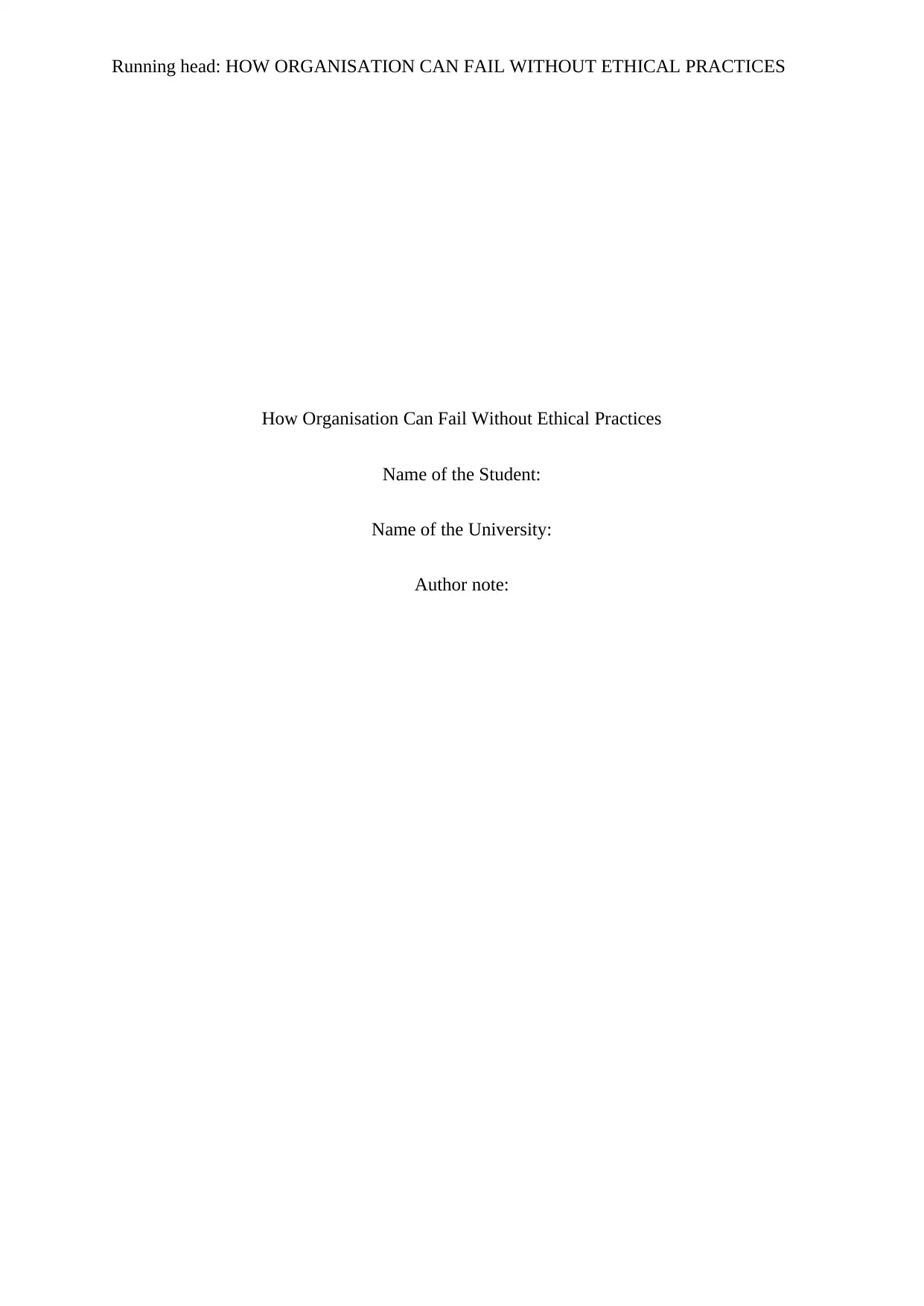
Running head: HOW ORGANISATION CAN FAIL WITHOUT ETHICAL PRACTICES
How Organisation Can Fail Without Ethical Practices
Name of the Student:
Name of the University:
Author note:
How Organisation Can Fail Without Ethical Practices
Name of the Student:
Name of the University:
Author note:
Paraphrase This Document
Need a fresh take? Get an instant paraphrase of this document with our AI Paraphraser
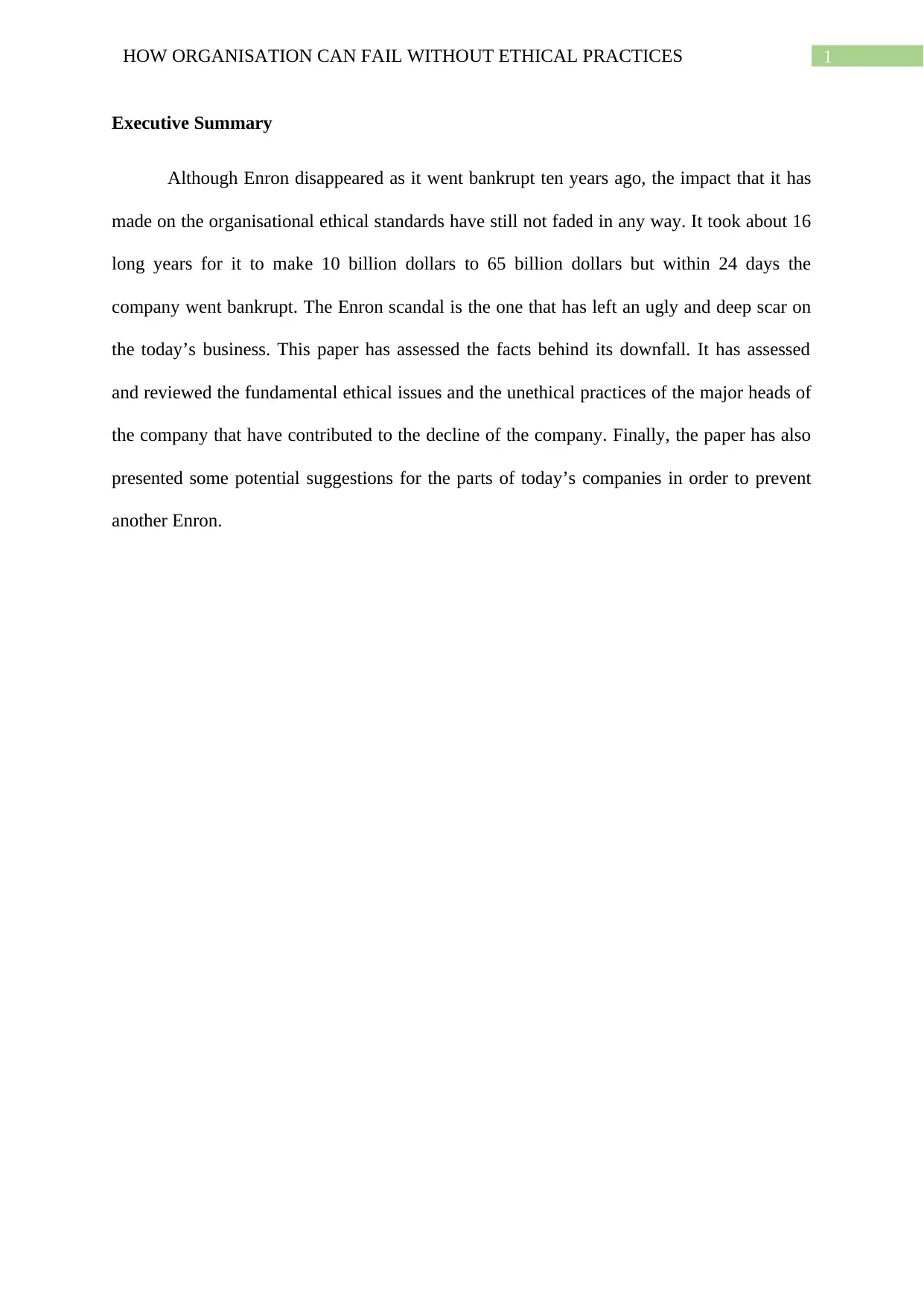
1HOW ORGANISATION CAN FAIL WITHOUT ETHICAL PRACTICES
Executive Summary
Although Enron disappeared as it went bankrupt ten years ago, the impact that it has
made on the organisational ethical standards have still not faded in any way. It took about 16
long years for it to make 10 billion dollars to 65 billion dollars but within 24 days the
company went bankrupt. The Enron scandal is the one that has left an ugly and deep scar on
the today’s business. This paper has assessed the facts behind its downfall. It has assessed
and reviewed the fundamental ethical issues and the unethical practices of the major heads of
the company that have contributed to the decline of the company. Finally, the paper has also
presented some potential suggestions for the parts of today’s companies in order to prevent
another Enron.
Executive Summary
Although Enron disappeared as it went bankrupt ten years ago, the impact that it has
made on the organisational ethical standards have still not faded in any way. It took about 16
long years for it to make 10 billion dollars to 65 billion dollars but within 24 days the
company went bankrupt. The Enron scandal is the one that has left an ugly and deep scar on
the today’s business. This paper has assessed the facts behind its downfall. It has assessed
and reviewed the fundamental ethical issues and the unethical practices of the major heads of
the company that have contributed to the decline of the company. Finally, the paper has also
presented some potential suggestions for the parts of today’s companies in order to prevent
another Enron.
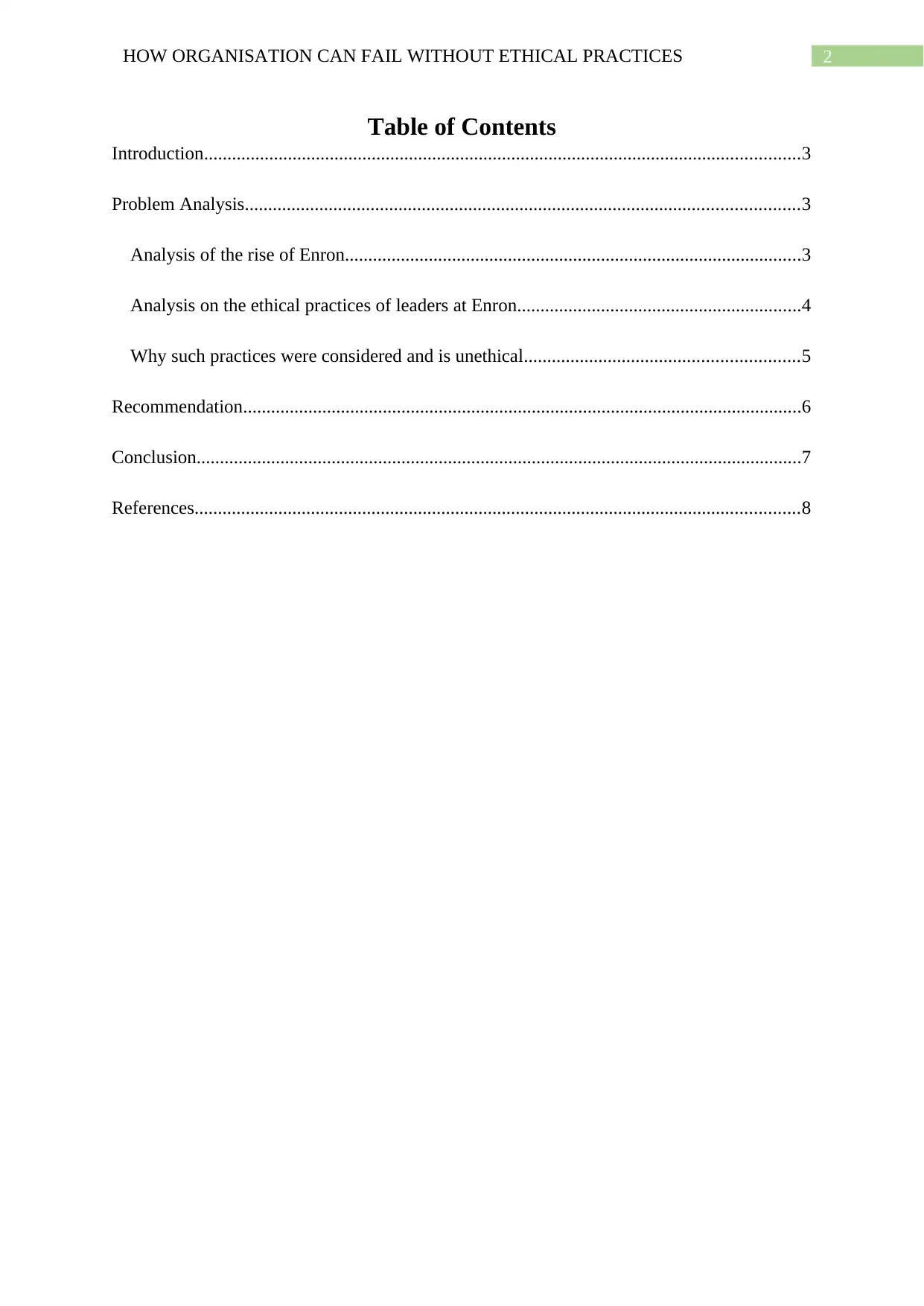
2HOW ORGANISATION CAN FAIL WITHOUT ETHICAL PRACTICES
Table of Contents
Introduction................................................................................................................................3
Problem Analysis.......................................................................................................................3
Analysis of the rise of Enron..................................................................................................3
Analysis on the ethical practices of leaders at Enron.............................................................4
Why such practices were considered and is unethical...........................................................5
Recommendation........................................................................................................................6
Conclusion..................................................................................................................................7
References..................................................................................................................................8
Table of Contents
Introduction................................................................................................................................3
Problem Analysis.......................................................................................................................3
Analysis of the rise of Enron..................................................................................................3
Analysis on the ethical practices of leaders at Enron.............................................................4
Why such practices were considered and is unethical...........................................................5
Recommendation........................................................................................................................6
Conclusion..................................................................................................................................7
References..................................................................................................................................8
⊘ This is a preview!⊘
Do you want full access?
Subscribe today to unlock all pages.

Trusted by 1+ million students worldwide
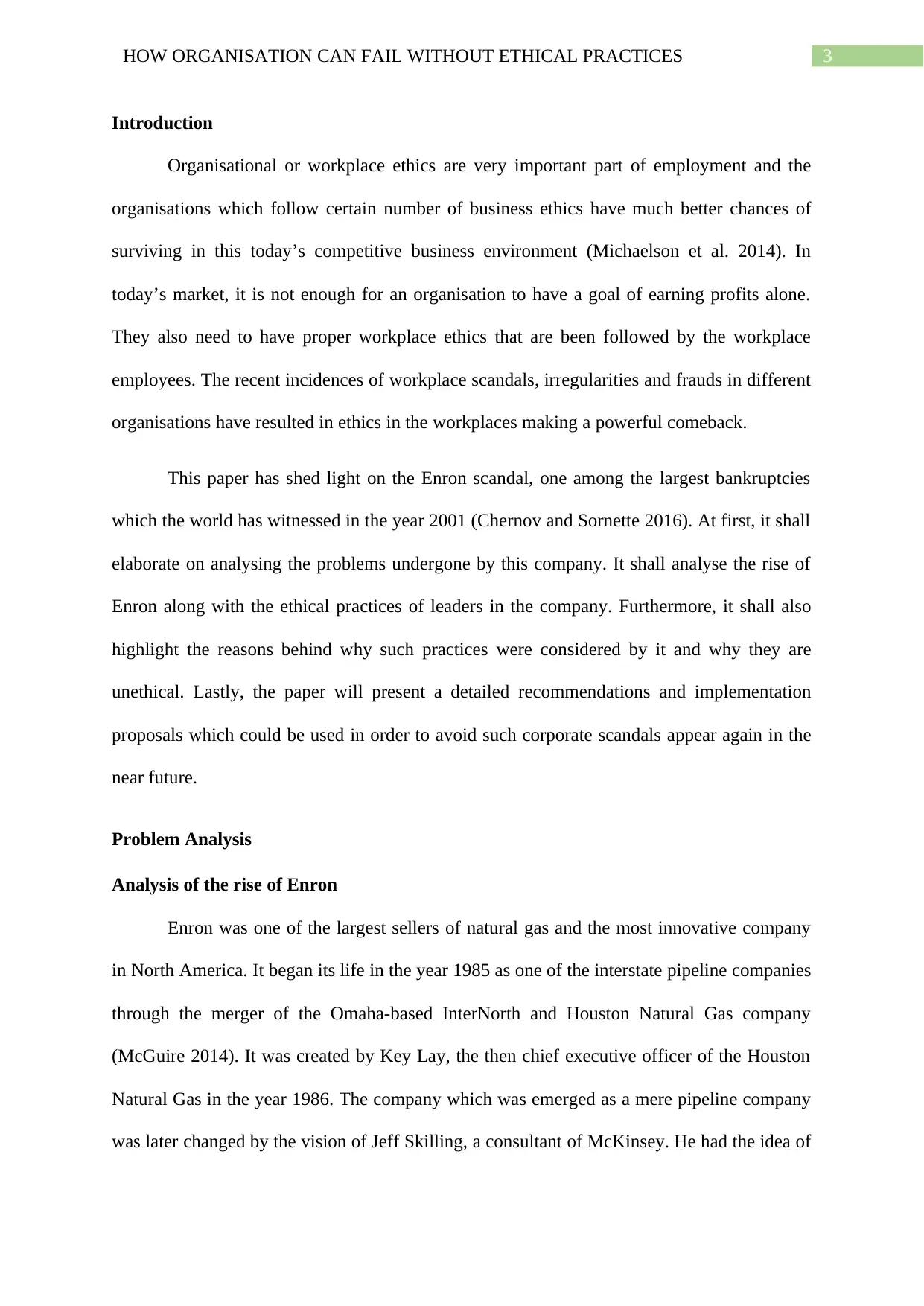
3HOW ORGANISATION CAN FAIL WITHOUT ETHICAL PRACTICES
Introduction
Organisational or workplace ethics are very important part of employment and the
organisations which follow certain number of business ethics have much better chances of
surviving in this today’s competitive business environment (Michaelson et al. 2014). In
today’s market, it is not enough for an organisation to have a goal of earning profits alone.
They also need to have proper workplace ethics that are been followed by the workplace
employees. The recent incidences of workplace scandals, irregularities and frauds in different
organisations have resulted in ethics in the workplaces making a powerful comeback.
This paper has shed light on the Enron scandal, one among the largest bankruptcies
which the world has witnessed in the year 2001 (Chernov and Sornette 2016). At first, it shall
elaborate on analysing the problems undergone by this company. It shall analyse the rise of
Enron along with the ethical practices of leaders in the company. Furthermore, it shall also
highlight the reasons behind why such practices were considered by it and why they are
unethical. Lastly, the paper will present a detailed recommendations and implementation
proposals which could be used in order to avoid such corporate scandals appear again in the
near future.
Problem Analysis
Analysis of the rise of Enron
Enron was one of the largest sellers of natural gas and the most innovative company
in North America. It began its life in the year 1985 as one of the interstate pipeline companies
through the merger of the Omaha-based InterNorth and Houston Natural Gas company
(McGuire 2014). It was created by Key Lay, the then chief executive officer of the Houston
Natural Gas in the year 1986. The company which was emerged as a mere pipeline company
was later changed by the vision of Jeff Skilling, a consultant of McKinsey. He had the idea of
Introduction
Organisational or workplace ethics are very important part of employment and the
organisations which follow certain number of business ethics have much better chances of
surviving in this today’s competitive business environment (Michaelson et al. 2014). In
today’s market, it is not enough for an organisation to have a goal of earning profits alone.
They also need to have proper workplace ethics that are been followed by the workplace
employees. The recent incidences of workplace scandals, irregularities and frauds in different
organisations have resulted in ethics in the workplaces making a powerful comeback.
This paper has shed light on the Enron scandal, one among the largest bankruptcies
which the world has witnessed in the year 2001 (Chernov and Sornette 2016). At first, it shall
elaborate on analysing the problems undergone by this company. It shall analyse the rise of
Enron along with the ethical practices of leaders in the company. Furthermore, it shall also
highlight the reasons behind why such practices were considered by it and why they are
unethical. Lastly, the paper will present a detailed recommendations and implementation
proposals which could be used in order to avoid such corporate scandals appear again in the
near future.
Problem Analysis
Analysis of the rise of Enron
Enron was one of the largest sellers of natural gas and the most innovative company
in North America. It began its life in the year 1985 as one of the interstate pipeline companies
through the merger of the Omaha-based InterNorth and Houston Natural Gas company
(McGuire 2014). It was created by Key Lay, the then chief executive officer of the Houston
Natural Gas in the year 1986. The company which was emerged as a mere pipeline company
was later changed by the vision of Jeff Skilling, a consultant of McKinsey. He had the idea of
Paraphrase This Document
Need a fresh take? Get an instant paraphrase of this document with our AI Paraphraser
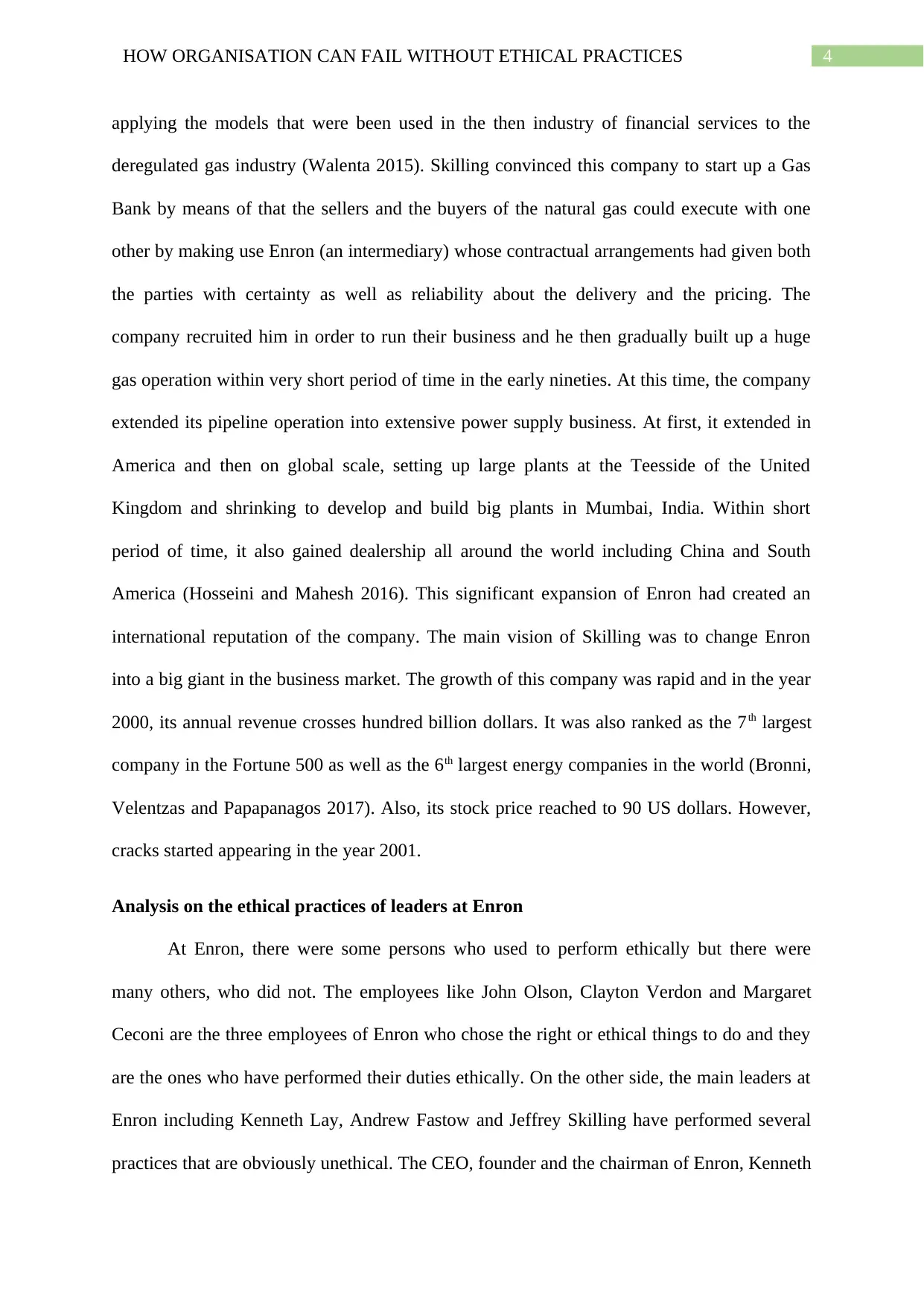
4HOW ORGANISATION CAN FAIL WITHOUT ETHICAL PRACTICES
applying the models that were been used in the then industry of financial services to the
deregulated gas industry (Walenta 2015). Skilling convinced this company to start up a Gas
Bank by means of that the sellers and the buyers of the natural gas could execute with one
other by making use Enron (an intermediary) whose contractual arrangements had given both
the parties with certainty as well as reliability about the delivery and the pricing. The
company recruited him in order to run their business and he then gradually built up a huge
gas operation within very short period of time in the early nineties. At this time, the company
extended its pipeline operation into extensive power supply business. At first, it extended in
America and then on global scale, setting up large plants at the Teesside of the United
Kingdom and shrinking to develop and build big plants in Mumbai, India. Within short
period of time, it also gained dealership all around the world including China and South
America (Hosseini and Mahesh 2016). This significant expansion of Enron had created an
international reputation of the company. The main vision of Skilling was to change Enron
into a big giant in the business market. The growth of this company was rapid and in the year
2000, its annual revenue crosses hundred billion dollars. It was also ranked as the 7th largest
company in the Fortune 500 as well as the 6th largest energy companies in the world (Bronni,
Velentzas and Papapanagos 2017). Also, its stock price reached to 90 US dollars. However,
cracks started appearing in the year 2001.
Analysis on the ethical practices of leaders at Enron
At Enron, there were some persons who used to perform ethically but there were
many others, who did not. The employees like John Olson, Clayton Verdon and Margaret
Ceconi are the three employees of Enron who chose the right or ethical things to do and they
are the ones who have performed their duties ethically. On the other side, the main leaders at
Enron including Kenneth Lay, Andrew Fastow and Jeffrey Skilling have performed several
practices that are obviously unethical. The CEO, founder and the chairman of Enron, Kenneth
applying the models that were been used in the then industry of financial services to the
deregulated gas industry (Walenta 2015). Skilling convinced this company to start up a Gas
Bank by means of that the sellers and the buyers of the natural gas could execute with one
other by making use Enron (an intermediary) whose contractual arrangements had given both
the parties with certainty as well as reliability about the delivery and the pricing. The
company recruited him in order to run their business and he then gradually built up a huge
gas operation within very short period of time in the early nineties. At this time, the company
extended its pipeline operation into extensive power supply business. At first, it extended in
America and then on global scale, setting up large plants at the Teesside of the United
Kingdom and shrinking to develop and build big plants in Mumbai, India. Within short
period of time, it also gained dealership all around the world including China and South
America (Hosseini and Mahesh 2016). This significant expansion of Enron had created an
international reputation of the company. The main vision of Skilling was to change Enron
into a big giant in the business market. The growth of this company was rapid and in the year
2000, its annual revenue crosses hundred billion dollars. It was also ranked as the 7th largest
company in the Fortune 500 as well as the 6th largest energy companies in the world (Bronni,
Velentzas and Papapanagos 2017). Also, its stock price reached to 90 US dollars. However,
cracks started appearing in the year 2001.
Analysis on the ethical practices of leaders at Enron
At Enron, there were some persons who used to perform ethically but there were
many others, who did not. The employees like John Olson, Clayton Verdon and Margaret
Ceconi are the three employees of Enron who chose the right or ethical things to do and they
are the ones who have performed their duties ethically. On the other side, the main leaders at
Enron including Kenneth Lay, Andrew Fastow and Jeffrey Skilling have performed several
practices that are obviously unethical. The CEO, founder and the chairman of Enron, Kenneth
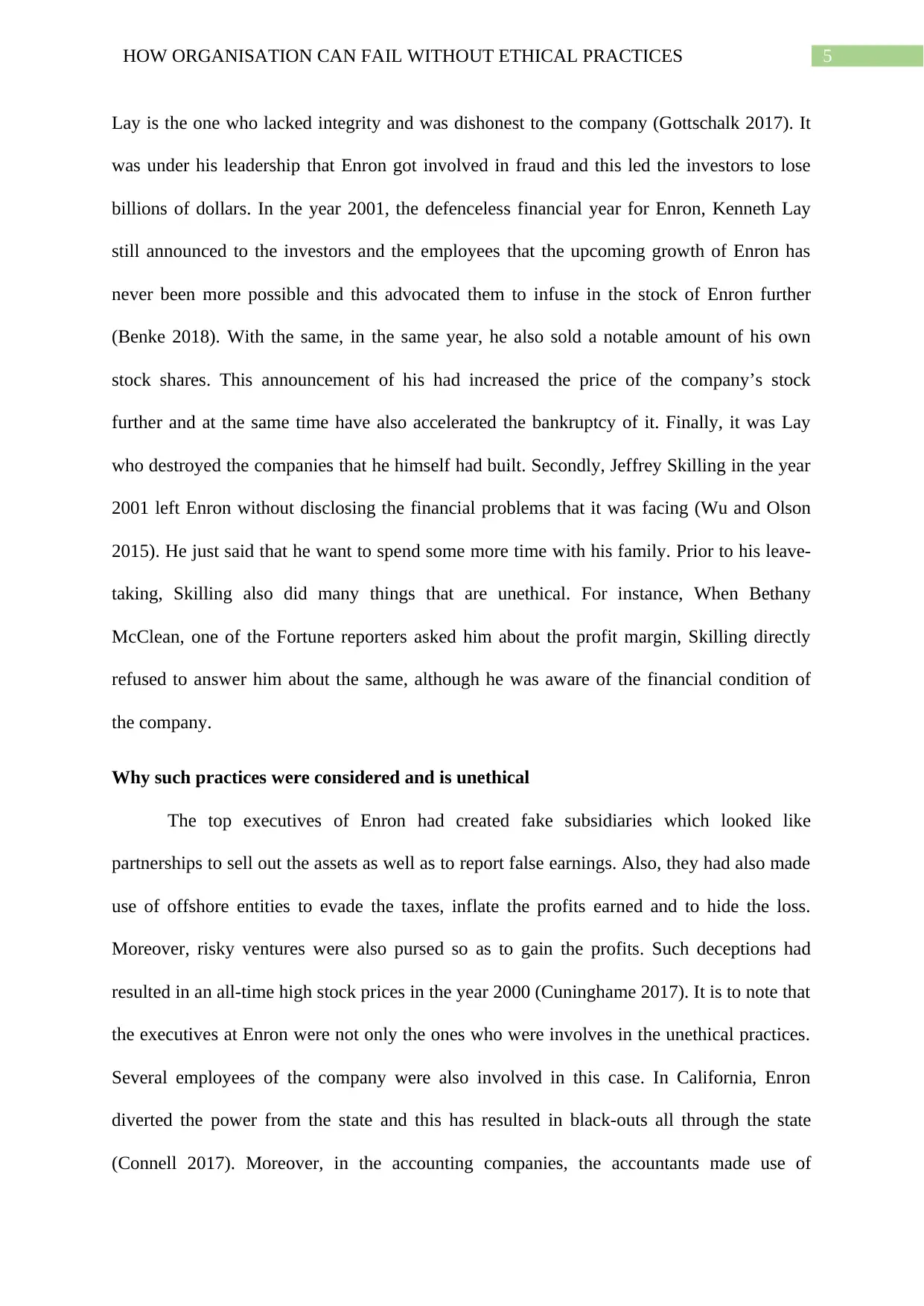
5HOW ORGANISATION CAN FAIL WITHOUT ETHICAL PRACTICES
Lay is the one who lacked integrity and was dishonest to the company (Gottschalk 2017). It
was under his leadership that Enron got involved in fraud and this led the investors to lose
billions of dollars. In the year 2001, the defenceless financial year for Enron, Kenneth Lay
still announced to the investors and the employees that the upcoming growth of Enron has
never been more possible and this advocated them to infuse in the stock of Enron further
(Benke 2018). With the same, in the same year, he also sold a notable amount of his own
stock shares. This announcement of his had increased the price of the company’s stock
further and at the same time have also accelerated the bankruptcy of it. Finally, it was Lay
who destroyed the companies that he himself had built. Secondly, Jeffrey Skilling in the year
2001 left Enron without disclosing the financial problems that it was facing (Wu and Olson
2015). He just said that he want to spend some more time with his family. Prior to his leave-
taking, Skilling also did many things that are unethical. For instance, When Bethany
McClean, one of the Fortune reporters asked him about the profit margin, Skilling directly
refused to answer him about the same, although he was aware of the financial condition of
the company.
Why such practices were considered and is unethical
The top executives of Enron had created fake subsidiaries which looked like
partnerships to sell out the assets as well as to report false earnings. Also, they had also made
use of offshore entities to evade the taxes, inflate the profits earned and to hide the loss.
Moreover, risky ventures were also pursed so as to gain the profits. Such deceptions had
resulted in an all-time high stock prices in the year 2000 (Cuninghame 2017). It is to note that
the executives at Enron were not only the ones who were involves in the unethical practices.
Several employees of the company were also involved in this case. In California, Enron
diverted the power from the state and this has resulted in black-outs all through the state
(Connell 2017). Moreover, in the accounting companies, the accountants made use of
Lay is the one who lacked integrity and was dishonest to the company (Gottschalk 2017). It
was under his leadership that Enron got involved in fraud and this led the investors to lose
billions of dollars. In the year 2001, the defenceless financial year for Enron, Kenneth Lay
still announced to the investors and the employees that the upcoming growth of Enron has
never been more possible and this advocated them to infuse in the stock of Enron further
(Benke 2018). With the same, in the same year, he also sold a notable amount of his own
stock shares. This announcement of his had increased the price of the company’s stock
further and at the same time have also accelerated the bankruptcy of it. Finally, it was Lay
who destroyed the companies that he himself had built. Secondly, Jeffrey Skilling in the year
2001 left Enron without disclosing the financial problems that it was facing (Wu and Olson
2015). He just said that he want to spend some more time with his family. Prior to his leave-
taking, Skilling also did many things that are unethical. For instance, When Bethany
McClean, one of the Fortune reporters asked him about the profit margin, Skilling directly
refused to answer him about the same, although he was aware of the financial condition of
the company.
Why such practices were considered and is unethical
The top executives of Enron had created fake subsidiaries which looked like
partnerships to sell out the assets as well as to report false earnings. Also, they had also made
use of offshore entities to evade the taxes, inflate the profits earned and to hide the loss.
Moreover, risky ventures were also pursed so as to gain the profits. Such deceptions had
resulted in an all-time high stock prices in the year 2000 (Cuninghame 2017). It is to note that
the executives at Enron were not only the ones who were involves in the unethical practices.
Several employees of the company were also involved in this case. In California, Enron
diverted the power from the state and this has resulted in black-outs all through the state
(Connell 2017). Moreover, in the accounting companies, the accountants made use of
⊘ This is a preview!⊘
Do you want full access?
Subscribe today to unlock all pages.

Trusted by 1+ million students worldwide
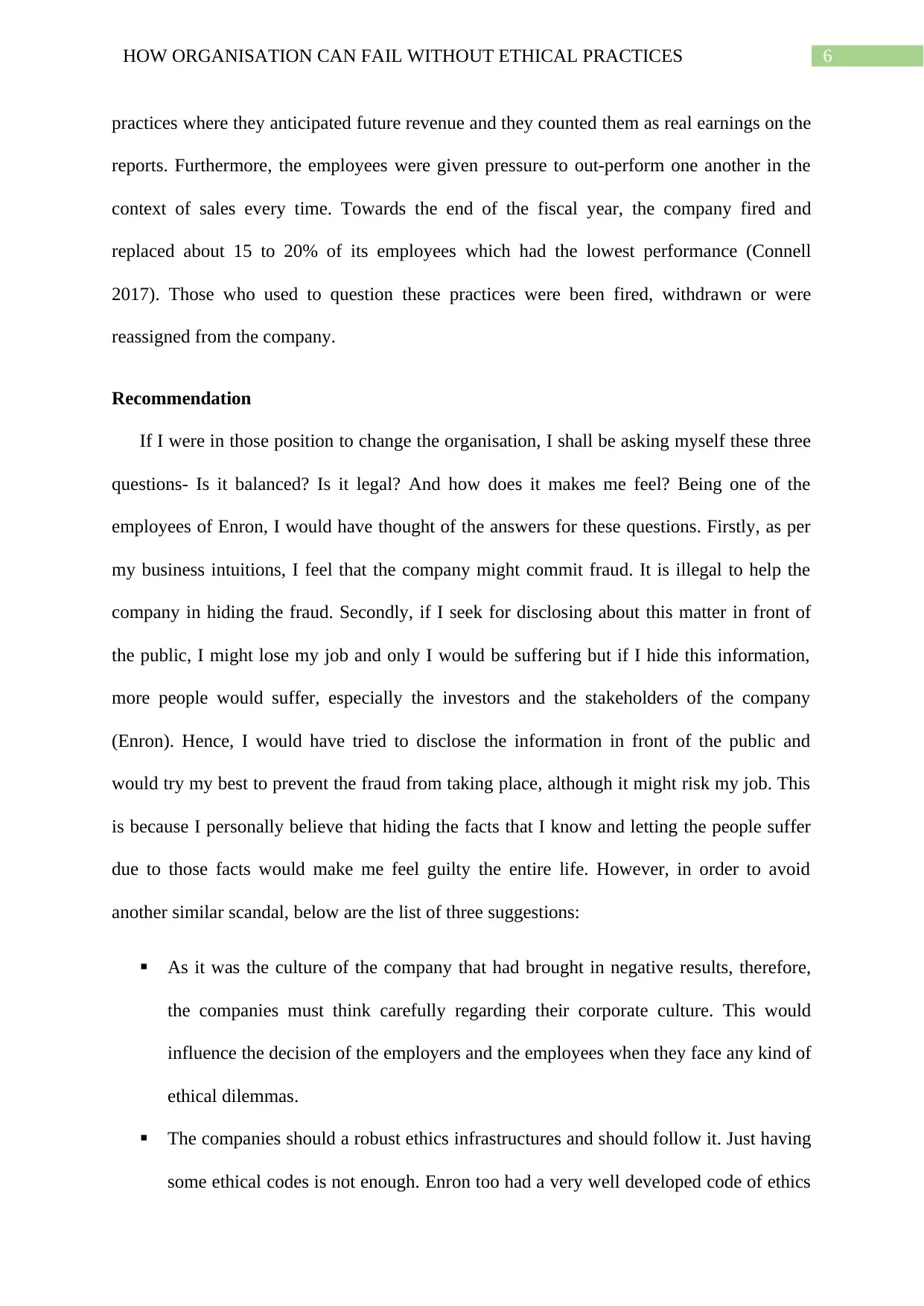
6HOW ORGANISATION CAN FAIL WITHOUT ETHICAL PRACTICES
practices where they anticipated future revenue and they counted them as real earnings on the
reports. Furthermore, the employees were given pressure to out-perform one another in the
context of sales every time. Towards the end of the fiscal year, the company fired and
replaced about 15 to 20% of its employees which had the lowest performance (Connell
2017). Those who used to question these practices were been fired, withdrawn or were
reassigned from the company.
Recommendation
If I were in those position to change the organisation, I shall be asking myself these three
questions- Is it balanced? Is it legal? And how does it makes me feel? Being one of the
employees of Enron, I would have thought of the answers for these questions. Firstly, as per
my business intuitions, I feel that the company might commit fraud. It is illegal to help the
company in hiding the fraud. Secondly, if I seek for disclosing about this matter in front of
the public, I might lose my job and only I would be suffering but if I hide this information,
more people would suffer, especially the investors and the stakeholders of the company
(Enron). Hence, I would have tried to disclose the information in front of the public and
would try my best to prevent the fraud from taking place, although it might risk my job. This
is because I personally believe that hiding the facts that I know and letting the people suffer
due to those facts would make me feel guilty the entire life. However, in order to avoid
another similar scandal, below are the list of three suggestions:
As it was the culture of the company that had brought in negative results, therefore,
the companies must think carefully regarding their corporate culture. This would
influence the decision of the employers and the employees when they face any kind of
ethical dilemmas.
The companies should a robust ethics infrastructures and should follow it. Just having
some ethical codes is not enough. Enron too had a very well developed code of ethics
practices where they anticipated future revenue and they counted them as real earnings on the
reports. Furthermore, the employees were given pressure to out-perform one another in the
context of sales every time. Towards the end of the fiscal year, the company fired and
replaced about 15 to 20% of its employees which had the lowest performance (Connell
2017). Those who used to question these practices were been fired, withdrawn or were
reassigned from the company.
Recommendation
If I were in those position to change the organisation, I shall be asking myself these three
questions- Is it balanced? Is it legal? And how does it makes me feel? Being one of the
employees of Enron, I would have thought of the answers for these questions. Firstly, as per
my business intuitions, I feel that the company might commit fraud. It is illegal to help the
company in hiding the fraud. Secondly, if I seek for disclosing about this matter in front of
the public, I might lose my job and only I would be suffering but if I hide this information,
more people would suffer, especially the investors and the stakeholders of the company
(Enron). Hence, I would have tried to disclose the information in front of the public and
would try my best to prevent the fraud from taking place, although it might risk my job. This
is because I personally believe that hiding the facts that I know and letting the people suffer
due to those facts would make me feel guilty the entire life. However, in order to avoid
another similar scandal, below are the list of three suggestions:
As it was the culture of the company that had brought in negative results, therefore,
the companies must think carefully regarding their corporate culture. This would
influence the decision of the employers and the employees when they face any kind of
ethical dilemmas.
The companies should a robust ethics infrastructures and should follow it. Just having
some ethical codes is not enough. Enron too had a very well developed code of ethics
Paraphrase This Document
Need a fresh take? Get an instant paraphrase of this document with our AI Paraphraser
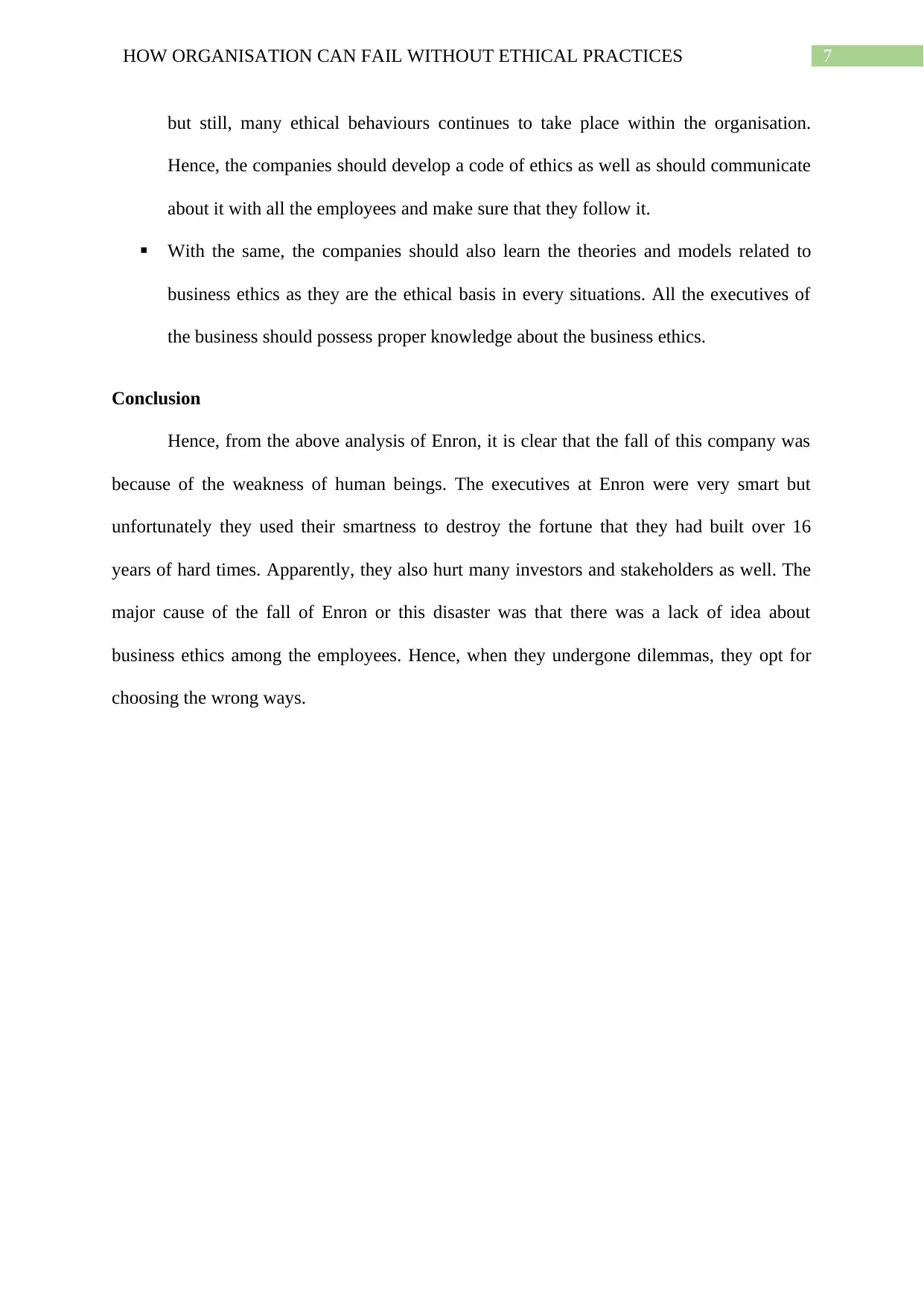
7HOW ORGANISATION CAN FAIL WITHOUT ETHICAL PRACTICES
but still, many ethical behaviours continues to take place within the organisation.
Hence, the companies should develop a code of ethics as well as should communicate
about it with all the employees and make sure that they follow it.
With the same, the companies should also learn the theories and models related to
business ethics as they are the ethical basis in every situations. All the executives of
the business should possess proper knowledge about the business ethics.
Conclusion
Hence, from the above analysis of Enron, it is clear that the fall of this company was
because of the weakness of human beings. The executives at Enron were very smart but
unfortunately they used their smartness to destroy the fortune that they had built over 16
years of hard times. Apparently, they also hurt many investors and stakeholders as well. The
major cause of the fall of Enron or this disaster was that there was a lack of idea about
business ethics among the employees. Hence, when they undergone dilemmas, they opt for
choosing the wrong ways.
but still, many ethical behaviours continues to take place within the organisation.
Hence, the companies should develop a code of ethics as well as should communicate
about it with all the employees and make sure that they follow it.
With the same, the companies should also learn the theories and models related to
business ethics as they are the ethical basis in every situations. All the executives of
the business should possess proper knowledge about the business ethics.
Conclusion
Hence, from the above analysis of Enron, it is clear that the fall of this company was
because of the weakness of human beings. The executives at Enron were very smart but
unfortunately they used their smartness to destroy the fortune that they had built over 16
years of hard times. Apparently, they also hurt many investors and stakeholders as well. The
major cause of the fall of Enron or this disaster was that there was a lack of idea about
business ethics among the employees. Hence, when they undergone dilemmas, they opt for
choosing the wrong ways.
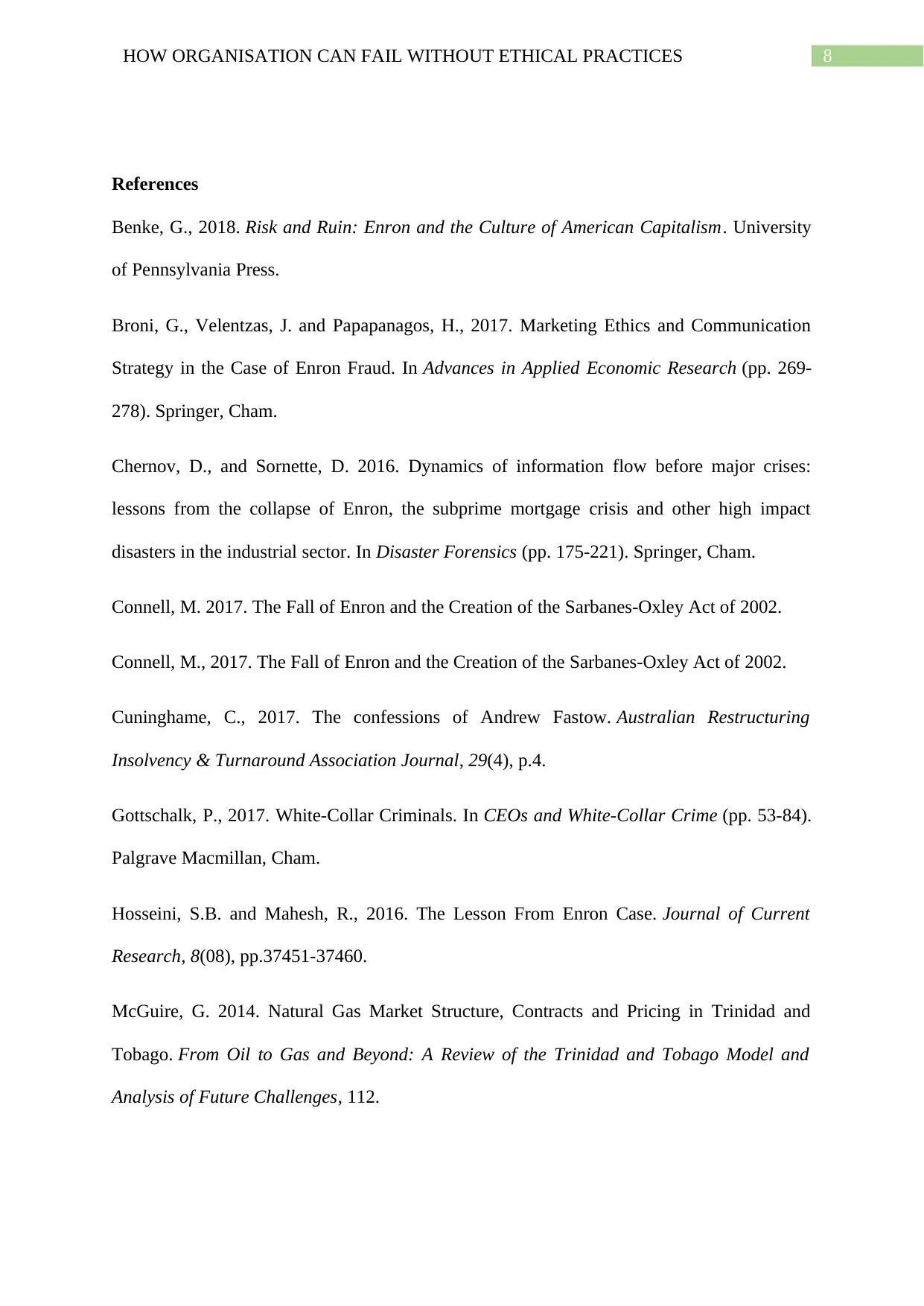
8HOW ORGANISATION CAN FAIL WITHOUT ETHICAL PRACTICES
References
Benke, G., 2018. Risk and Ruin: Enron and the Culture of American Capitalism. University
of Pennsylvania Press.
Broni, G., Velentzas, J. and Papapanagos, H., 2017. Marketing Ethics and Communication
Strategy in the Case of Enron Fraud. In Advances in Applied Economic Research (pp. 269-
278). Springer, Cham.
Chernov, D., and Sornette, D. 2016. Dynamics of information flow before major crises:
lessons from the collapse of Enron, the subprime mortgage crisis and other high impact
disasters in the industrial sector. In Disaster Forensics (pp. 175-221). Springer, Cham.
Connell, M. 2017. The Fall of Enron and the Creation of the Sarbanes-Oxley Act of 2002.
Connell, M., 2017. The Fall of Enron and the Creation of the Sarbanes-Oxley Act of 2002.
Cuninghame, C., 2017. The confessions of Andrew Fastow. Australian Restructuring
Insolvency & Turnaround Association Journal, 29(4), p.4.
Gottschalk, P., 2017. White-Collar Criminals. In CEOs and White-Collar Crime (pp. 53-84).
Palgrave Macmillan, Cham.
Hosseini, S.B. and Mahesh, R., 2016. The Lesson From Enron Case. Journal of Current
Research, 8(08), pp.37451-37460.
McGuire, G. 2014. Natural Gas Market Structure, Contracts and Pricing in Trinidad and
Tobago. From Oil to Gas and Beyond: A Review of the Trinidad and Tobago Model and
Analysis of Future Challenges, 112.
References
Benke, G., 2018. Risk and Ruin: Enron and the Culture of American Capitalism. University
of Pennsylvania Press.
Broni, G., Velentzas, J. and Papapanagos, H., 2017. Marketing Ethics and Communication
Strategy in the Case of Enron Fraud. In Advances in Applied Economic Research (pp. 269-
278). Springer, Cham.
Chernov, D., and Sornette, D. 2016. Dynamics of information flow before major crises:
lessons from the collapse of Enron, the subprime mortgage crisis and other high impact
disasters in the industrial sector. In Disaster Forensics (pp. 175-221). Springer, Cham.
Connell, M. 2017. The Fall of Enron and the Creation of the Sarbanes-Oxley Act of 2002.
Connell, M., 2017. The Fall of Enron and the Creation of the Sarbanes-Oxley Act of 2002.
Cuninghame, C., 2017. The confessions of Andrew Fastow. Australian Restructuring
Insolvency & Turnaround Association Journal, 29(4), p.4.
Gottschalk, P., 2017. White-Collar Criminals. In CEOs and White-Collar Crime (pp. 53-84).
Palgrave Macmillan, Cham.
Hosseini, S.B. and Mahesh, R., 2016. The Lesson From Enron Case. Journal of Current
Research, 8(08), pp.37451-37460.
McGuire, G. 2014. Natural Gas Market Structure, Contracts and Pricing in Trinidad and
Tobago. From Oil to Gas and Beyond: A Review of the Trinidad and Tobago Model and
Analysis of Future Challenges, 112.
⊘ This is a preview!⊘
Do you want full access?
Subscribe today to unlock all pages.

Trusted by 1+ million students worldwide
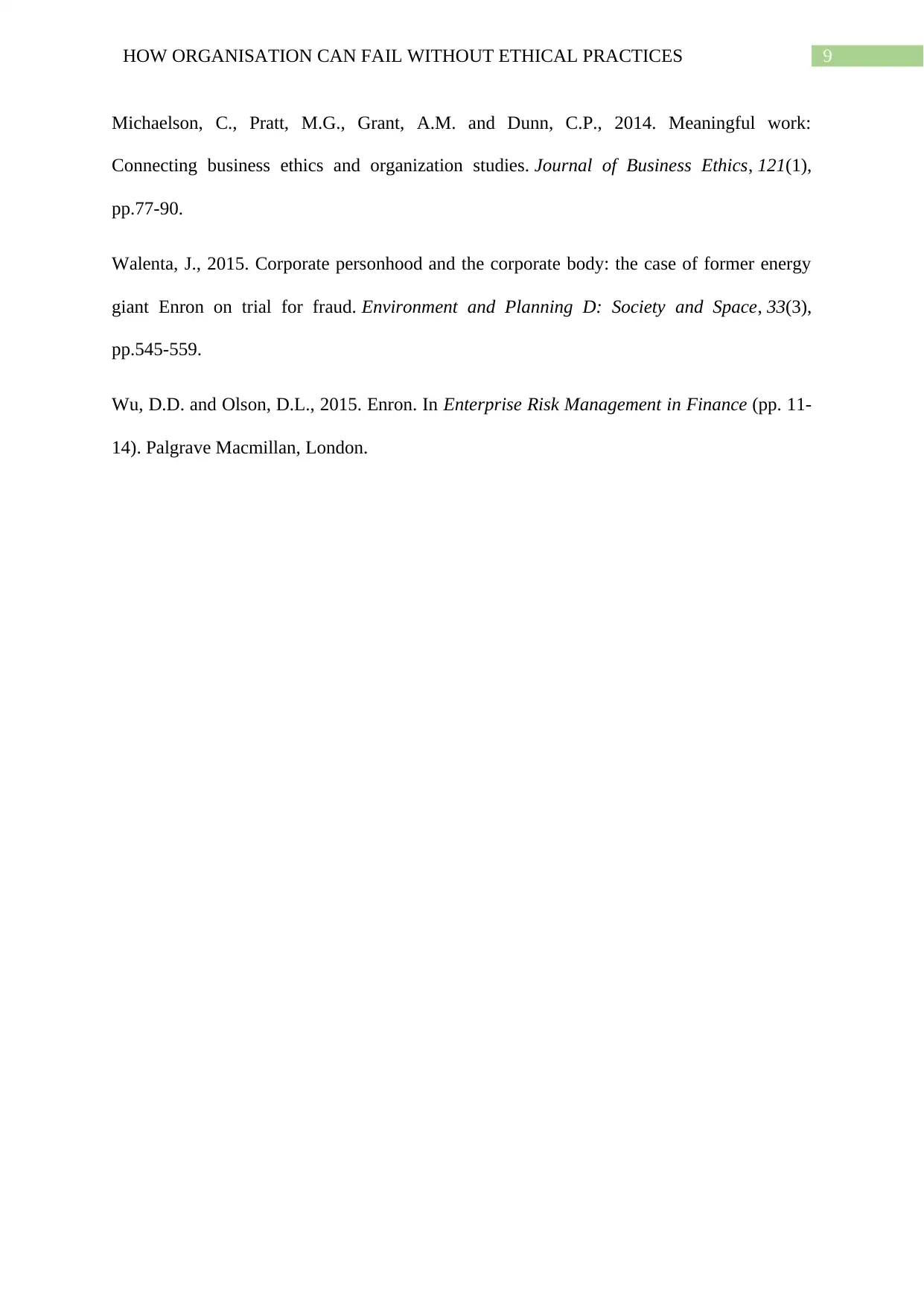
9HOW ORGANISATION CAN FAIL WITHOUT ETHICAL PRACTICES
Michaelson, C., Pratt, M.G., Grant, A.M. and Dunn, C.P., 2014. Meaningful work:
Connecting business ethics and organization studies. Journal of Business Ethics, 121(1),
pp.77-90.
Walenta, J., 2015. Corporate personhood and the corporate body: the case of former energy
giant Enron on trial for fraud. Environment and Planning D: Society and Space, 33(3),
pp.545-559.
Wu, D.D. and Olson, D.L., 2015. Enron. In Enterprise Risk Management in Finance (pp. 11-
14). Palgrave Macmillan, London.
Michaelson, C., Pratt, M.G., Grant, A.M. and Dunn, C.P., 2014. Meaningful work:
Connecting business ethics and organization studies. Journal of Business Ethics, 121(1),
pp.77-90.
Walenta, J., 2015. Corporate personhood and the corporate body: the case of former energy
giant Enron on trial for fraud. Environment and Planning D: Society and Space, 33(3),
pp.545-559.
Wu, D.D. and Olson, D.L., 2015. Enron. In Enterprise Risk Management in Finance (pp. 11-
14). Palgrave Macmillan, London.
1 out of 10
Related Documents
Your All-in-One AI-Powered Toolkit for Academic Success.
+13062052269
info@desklib.com
Available 24*7 on WhatsApp / Email
![[object Object]](/_next/static/media/star-bottom.7253800d.svg)
Unlock your academic potential
Copyright © 2020–2025 A2Z Services. All Rights Reserved. Developed and managed by ZUCOL.





